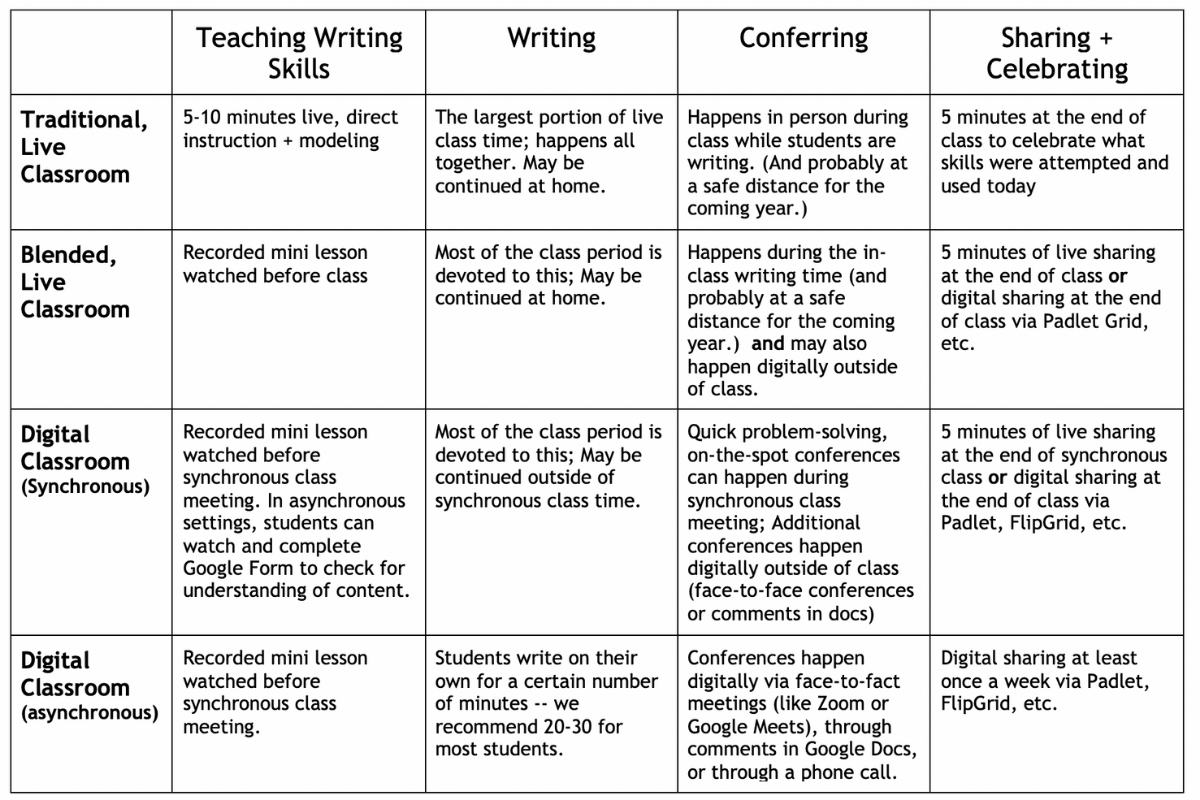
Writing Workshop That Can Thrive in a Pandemic
How to Make Your Writing Workshop Thrive - Whether In Person, Online, or a Blend of Both. By Allison Marchetti and Rebekah O'Dell
When we are adrift -- personally or instructionally -- we try to pause in the panic and ask, “What do we know is true?”
And that’s what we’re asking ourselves now as try to plan for thriving writing workshops. What do we know is true about writing instruction? What is essential? And how can we plan now to minimize the scope of the pivots we will have to make down the road?
What do we know is true about writing instruction? What is essential? And how can we plan now to minimize the scope of the pivots we will have to make down the road?
Dana Johansen and Dr. Sonja Cherry-Paul have been way ahead of us. Their book Flip Your Writing Workshop (Heinemann 2016) helped us begin thinking about flipped and blended instruction in writing workshop years ago. We can’t recommend this book highly enough -- it is full of practical, use-tomorrow ideas to make moving instruction online feel both doable and meaningful.
Flip Your Writing Workshop argues that blended learning can actually be good for both teachers and students as it helps differentiate instruction, foster independent learning, increase efficiency, and promote engagement -- qualities our instruction needs whether face-to-face or entirely online (Johansen + Cherry-Paul, 5-6).
Rereading their book this spring has led us to an important realization: we can digitize our writing workshops in ways that benefit students when they are in completely live, traditional classrooms AND when they are engaged in blended or remote learning. And if we plan this way now, we might just improve our workshops and reduce whiplash for both teacher and student down the road.
We can digitize our writing workshops in ways that benefit students when they are in completely live, traditional classrooms AND when they are engaged in blended or remote learning.
One thing that we can do right now, even with all the question marks about next year, is refamiliarize ourselves with the anchoring principles of a strong writing workshop.These principles and defining features don’t change when the learning environment changes, and keeping them at the forefront of our planning helps us prioritize what’s most important no matter where we are teaching. In writing workshop, we:
- Teach concrete writing skills
- Provide daily invitations to write
- Confer with writers to teach them writing strategies, learn about their writing lives, and help them plan future writing projects
- Create spaces for students to share their work and celebrate the work of others
Ultimately, it’s these principles that allow us to be instructionally flexible: the principles remain the same, but the way we engage with them can look different in various learning settings. As you look at this chart outlining the ways workshop changes to adapt to different learning environments, you’ll notice that when we keep students at the center of our teaching, the shifts aren’t huge:
 Let’s look at a handful of strategies for carrying out the principles of writing workshop in a blended learning environment.
Let’s look at a handful of strategies for carrying out the principles of writing workshop in a blended learning environment.
Teach concrete writing skills
A five-ten minute mini-lesson is designed to be a short burst of direct instruction that teaches students a single skill that will help them in their writing. This is also the ideal place to leverage blended learning. In the classroom or online, recording the mini-lesson and teacher modeling using free screencasting platforms (Loom, Screencastify, Screencast-O-Matic) frees up class time for writing, sharing, and conferring.
Maybe more importantly, recorded mini-lessons also enable students to watch and rewatch the lesson as many times as they need to. If students are unable to attend synchronous, online class meetings, the recorded mini-lesson lets every student participate in learning when they are able. Johansen and Cherry-Paul recommend having students watch the mini-lesson before class and then using an entrance ticket to determine what students learned in the mini-lesson and what they are planning to try in their own writing.
Recorded mini-lessons enable students to watch and rewatch the lesson as many times as they need to.
This is where we can begin our adjustments for next year. Flipping mini-lessons is something we know we will do in the fall from the get-go and keep as a mainstay of workshop next year when we are in person and when we are not. (Establishing a routine of recorded mini-lessons will also help you when you have to be out and leave your students with a substitute -- the learning will go on!)
Recorded mini-lessons are more effective when they are shorter -- try to keep them to 5-7 minutes. And do yourself a favor: make a hard-and-fast rule for yourself that you will record each mini-lesson in one take. Flipping lessons only becomes a time drain when you aim for Hollywood perfection. Simple videos that feel natural (just like you would be in person) are what your students really need.
Consider, too, sharing this responsibility with a trusted teacher friend who might be teaching similar lessons. We have a shared Google folder where we pool all of our recorded lessons.
Provide daily invitations to write
One of the most powerful statements we make in writing workshop is that the writing itself is so important that we will dedicate loads of class time to it. For us, time and space to write is non-negotiable.
One way we do this is through small, informal daily writing invitations. We call this time where we build ideas and writing muscles “notebook time”. (You can find ideas for notebook time on our blog here). This is the perfect kind of writing to send students each day via email or post to your school’s LMS. If your students are away from school and without Internet access, a stack of notebook writing invitations stapled together would make a meaningful work packet. (In fact, we have 200 tiny writing invitations here that you can curate, print, and staple for students without online access.)
In our classrooms, we also make time for students to do the deeper, longer writing that ultimately creates finished, polished pieces. In fact, sitting together to write is how we spend the majority of our class period. If you have the gift of synchronous online time with your students, this is still how we recommend you spend that time. Writing together -- even through a computer screen -- builds community, gives students a chance to get in-the-moment help from the teacher, and ensures students have the time and space for writing. This past spring, with 90 minutes of synchronous class time per week, this (plus sharing and celebrating) is how we chose to use those scheduled, synchronous class minutes.
 Ask students to set a timer and write for a certain number of minutes.
Ask students to set a timer and write for a certain number of minutes.
Let’s be honest: if you don’t have synchronous class time with your students, building in the time for writing will be much harder. Rather than asking students to write a certain number of pages or paragraphs, we recommend asking students to set a timer and write for a certain number of minutes. (20-30 minutes seems to be the right amount for most middle and high school writers, but you know your students best and can adjust or differentiate this time to meet their needs!) This feels less overwhelming and equals the writing field -- “slow” writers won’t be spending hours toiling over each sentence while “fast” writers spend only a few minutes before moving on.
Confer with writers to teach them writing strategies, learn about their writing lives, and help them plan future writing projects
When we are able to create synchronous writing time, some conferring naturally follows. This spring, while students were writing in our Google Meet, Rebekah shared her screen and modeled her own writing. Periodically, a student would unmute to ask a quick question. And just like face-to-face conferring in the classroom, other students would benefit from hearing that conversation.
Those quick on-the-spot help conferences aren’t always enough, though. So, in a blended or completely online learning environment, we have to make time for outside-class-time, digital conferences with writers. Scheduling open online office hours is one way to do this, and if you’re nervous about the whole class showing up at once, you can always create a digital sign up for 10-minute time slots. Be sure to also offer the option of phone conferences for students who may not have a stable internet connection or may have to share computers with other family members.
To better balance your own time, pull students into small groups for writing conferences in 20-25 minute blocks of time. Students don’t need to be scientifically grouped -- you can schedule a conference for a random group of 4-5 writers or loosely group them according to the general needs you already know. Even if you are checking in with each writer briefly, students will benefit from hearing other writing conferences.
For us and for many teachers, live, digital conferences via Zoom or Google Meets have been the highlight of online teaching. A few minutes of conversation with writers restores our connection with students, and if that conversation is one-on-one, it’s often even more productive than conferences in our classrooms when students might be a bit shy or distracted by other students in the room. Small group conferences also reinforce students’ connections with one another, which are so easily lost in an online environment.
If live, digital conferences aren’t a possibility for you and your students, you can still have meaningful conferences through comments in Google Docs. Ask your students to leave comments with specific questions, trouble spots, or places where they would like some feedback. Make sure they tag you in that comment, and their questions will pop to your email inbox. You can reply right there in the email or open the Google Doc to see the whole draft. One benefit of these asynchronous conferences is that students tend to take more ownership as they drive the focus and content of the conversation. Voxer, a walkie-talkie app you use from a computer or a phone, is another way to share problems and ideas about a piece of writing in a human way without meeting face-to-face.
Sharing and celebrating writing is what makes our classroom a true community of writers.
Create spaces for students to share their work and celebrate the work of others
Sharing and celebrating writing is what makes our classroom a true community of writers. When we are teaching online, it’s also a tool for engagement. Save the last five minutes of a synchronous class meeting for sharing -- have one student sit in the metaphorical author’s chair and share what they have been working on or let multiple students share a favorite sentence or favorite idea they worked on during writing time that day. Students can also share in the chat box.
For more extensive sharing, invite students to share bits of writing on a Padlet wall, or a Flipgrid video, or via Seesaw. These platforms will also give students the ability to like or comment on each other’s work, giving your online classroom the feeling of sharing in an “author’s chair”.
So this summer, if you find yourself feeling lost or overwhelmed as you sit down with your planner, remember this: the framework and principles of workshop hold fast regardless of the learning environment. And whether we’re in classrooms, or online, or a combination of both next year, there are a few things you can do now (refamiliarize yourself with the tenets of workshop, practice making a digital lesson, decide where your online content will live) that will soften any shifts you have to make during the school-year.
Workshop is wonderfully predictable, rhythmic, routinized. It can thrive across time and space. And at the end of the day, what matters most is what always mattered most: our students, their ideas, their truths, and the many spaces that hold them.
•••
Allison Marchetti and Rebekah O'Dell are the coauthors of Writing with Mentors: How to Reach Every Writer in the Room Using Current, Engaging Mentor Texts. Learn more about this title on Heinemann.com or by clicking the book cover below.
 Allison Marchetti is coauthor—with Rebekah O'Dell—of Writing with Mentors and Beyond Literary Analysis. Their popular blog Moving Writers focuses on writing instruction in middle and high school classrooms with an emphasis on voice and authenticity. Traveling the country to work with teachers and students provides constant inspiration as they help educators do the hard-and-transformative work of teaching real writing.
Allison Marchetti is coauthor—with Rebekah O'Dell—of Writing with Mentors and Beyond Literary Analysis. Their popular blog Moving Writers focuses on writing instruction in middle and high school classrooms with an emphasis on voice and authenticity. Traveling the country to work with teachers and students provides constant inspiration as they help educators do the hard-and-transformative work of teaching real writing.
Allison has taught middle and high school English in both public and independent schools in Richmond, Virginia. Her favorite moments in the classroom happen at students’ desks, thinking and reading and writing beside them.
 Rebekah O'Dell is coauthor—with Allison Marchetti—of Writing with Mentors and Beyond Literary Analysis. Their popular blog Moving Writers focuses on writing instruction in middle and high school classrooms with an emphasis on voice and authenticity. Traveling the country to work with teachers and students provides constant inspiration as they help educators do the hard-and-transformative work of teaching real writing.
Rebekah O'Dell is coauthor—with Allison Marchetti—of Writing with Mentors and Beyond Literary Analysis. Their popular blog Moving Writers focuses on writing instruction in middle and high school classrooms with an emphasis on voice and authenticity. Traveling the country to work with teachers and students provides constant inspiration as they help educators do the hard-and-transformative work of teaching real writing.
After more than a decade in the high school classroom, Rebekah currently teaches middle school English in Richmond, Virginia. She has experience using the reading and writing workshop model to transform student engagement at all levels, from inclusion classrooms to the International Baccalaureate program.



